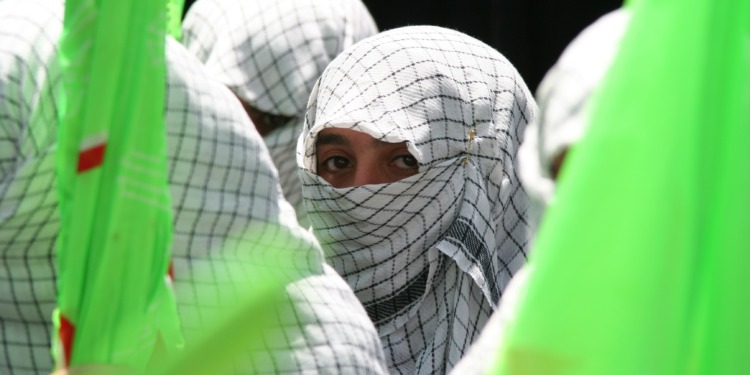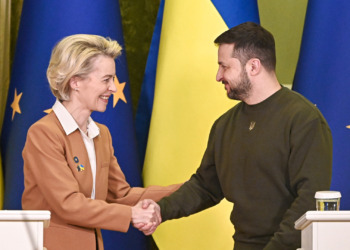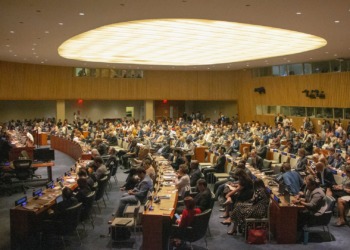This article was updated on September 27, the 12th day of the protests in Iran.
- Just under two weeks since the death of 22-year-old Mahsa Amini after she was arrested by the Iranian “morality police,” though President Raisi has said an investigation into her death will be launched, at present coroners claim she died of natural causes.
- The protests sparked by Amini’s death are now taking place in not only over 80 cities across Iran, but also across the globe. Demonstrators in Canada, London, Syria, Iraq, and Chile have taken to the streets to protest female oppression.
- Elon Musk has announced he will provide internet access via his Starlink satellite to the Iranian people, who are facing the largest internet blackout the country has seen since the protests of 2019. Many are concerned the blackout has been ordered to hide the actions of the Iranian forces.
- With at least 76 now reported dead, and another 1,200 arrested, Iranian authorities have received criticism for their handling of Amini’s death and the brutality of their crackdown on protesters.
- Iranian officials are blaming the West for fueling the unrest in an attempt to destabilize the country. The international community has responded with further sanctions on Iran, as Canada, the US, and the EU all consider imposing additional penalties on the authorities responsible.
As he spoke at the 77th UN General Assembly in New York City yesterday, Iran’s President, Seyyed Ebrahim Raisi, negotiated nuclear deals and de-cried Western double-standards. He did not speak of the current state of protests in his country, where there an internet blackout, women were burning their hijabs in the street, and eight people died as a result of intensifying anti-regime protests.
Over the past seven days, waves of women’s rights protests have spread rapidly across dozens of cities in Iran, as the women of the country have taken to the streets with anger and defiance against the authorities and strict hijab-laws that oppress their freedom, in what has become the biggest challenge the regime has seen in years.
Videos of public moral outrage and widespread protest have swept across social media, with eyewitnesses and human rights groups saying authorities have cracked-down hard on protestors, using tear-gas, violence and internet blackouts to try and contain the demonstrations.
These women in #Iran’s northern city of Sari are dancing and burning their headscarves… anti-regime protests have now spread to dozens of cities from north to south, east to west… all triggered by the death of #MahsaAmini while in the custody of Iran’s morality police. pic.twitter.com/BBDvgC5L1w
— Rana Rahimpour (@ranarahimpour) September 20, 2022
The escalating unrest was ignited by the death of a young woman, Mahsa Amini, after she was arrested by the Iranian “morality police” – or “Gasht-e Ershad” – last week, due to her allegedly breaking hijab rules.
At the entrance to a subway station in Tehran on Tuesday, Mahsa Amini was arrested by “morality police” for not wearing her hijab correctly, and was driven away in a police van where eyewitnesses say she was violently beaten by authorities.
Mahsa was 22 years old, and had traveled with her brother from their home in western Iran to visit family members in the capital city. Authorities initially told Amini’s brother that she would be released after attending a “briefing class;” instead, after collapsing at the detention centre, she was admitted to Kasra hospital and pronounced brain dead on arrival. Amini later died at the hospital on Friday, after spending three days in a coma.
The world wants justice for #Mahsa_Amini ✊ pic.twitter.com/abCsJwrxh1
— Amnesty International (@amnesty) September 22, 2022
Authorities have denied accusations of violence against Ms Amini, claiming she died due to “sudden heart failure.” Her family, however, have vehemently opposed the police’s statement, saying she was fit and healthy at the time of her arrest.
“Justice, liberty, NO to mandatory hijab”
Videos posted online of the unprecedented events unfolding across Iran have shown the magnitude of outrage felt by the Iranian people in response to Mahsa Amani’s death, as well as their anger at the decades of female oppression endured.
Women of all ages have been at the forefront of clashes with the authorities during the protests, defiantly committing a range of acts and demonstrations punishable by Iranian law.
Unbelievable scenes from #Tehran: a woman standing on a car, wearing western clothes, takes off her hijab and waves it in defiance at #Iran's religious police.#MahsaAmini #IranProtests2022pic.twitter.com/iFs14IhXl7
— Ahmed Quraishi (@_AhmedQuraishi) September 22, 2022
One older woman was shown on social media to be shouting at the authorities, “if you think you are a man, come and kill me,” whilst Tehran’s university campus saw crowds of students chanting: “Killings after killings, to hell with morality police!”
There have also been widespread scenes of female liberty as women publicly remove and burn their head-scarfs on street bonfires, cutting their hair as crowds cheer them on chanting “death to the dictator” and “life, liberty and women.”
Unprecedented scenes in Iran: woman sits on top of utility box and cuts her hair in main square in Kerman to protest death of Mahsa Amini after her arrest by the morality police. People clap their hands and chant “Death to the dictator.” #مهسا_امینی pic.twitter.com/2oyuKV80Ac
— Golnaz Esfandiari (@GEsfandiari) September 20, 2022
Over the course of six intensifying days of protest, many police vehicles have been damaged and burned, with Islamic Republic symbols and images of the republic’s founder, Ayatollah Ruhollah Khomeini, being torn down and destroyed.
The authorities have responded to the protests with “security forces have reportedly responded with live ammunition, pellet guns and teargas,” the UN stated. As one human rights group reported, at least 450 people have been injured and a further 500 arrested so far.
The groups also reported that authorities opened direct fire on protestors, with eight deaths so far, one of which involved a 16 year-old boy being shot in the head by police.
Access to the internet and social media platforms was also restricted yesterday, which has caused growing concern amongst activists who liken the move to a similar blackout that preluded the deaths of more than 1000 people as part of a crackdown during the nation’s last widespread protests over fuel prices in 2019.
Many have suggested the widespread unrest has been building for some time due to long-term oppression and economic hardship, boiling over last week after Amini’s death and after President Raisi implemented stricter Hijab and Chastity law last month.
What are the Hijab laws in Iran?
Since the Iranian Revolution in 1979 – an uprising that toppled the monarchy and formed the Islamic Republic – women have been forced by law to wear “proper clothing” in public, involving a headscarf (hijab) and loose-fitting clothing to hide their hair and figures.
According to government policy, if caught showing too much hair, wearing excessive make-up, or if the female body shape is revealed by short or close-fitting clothing, morality police officers have the authority to fine, imprison or subject women to flogging.
Related Articles: Protests in Iran and the Reasons Behind Them | Iran Nuclear Talks Resume, but Is It Serious or Stalling? | SDG 5: Achieving Gender Equality
After the 2021 election of current President Raisi the mandatory dress-code for women was strengthened with a new list of further restrictions and punishments, signed into law on August 15 of this year.
The government even plans to use facial recognition in public spaces to crackdown on infringements of the new hijab law, as announced by Iran’s Headquarters for Promoting Virtue and Preventing Vice.
“The regime combines violent ‘old-fashioned’ forms of totalitarian control dressed up in new technologies,” said Azadeh Akbari, a researcher in the Netherlands.
Pic of the Day: People chant slogans on a street in the capital city of Tehran amid nationwide protests over the death of #MahsaAmini. She was detained by morality police for violating #Iran's mandetory hijab rule & died in police custody. #IranProtests2022 #IranProtests
📷 AP pic.twitter.com/JIUQWQQKPd— Reza H. Akbari (@rezahakbari) September 22, 2022
What is likely to come from this?
The UN High Commissioner for Human Rights, Nada al-Nashif, has expressed alarm at Mahsa Amini’s death, condemning the moral police’s escalating violence against Iranian women.
She called for repeal of hijab law in the country, stating that “the authorities must stop targeting, harassing, and detaining women who do not abide by the hijab rules.”
“Mahsa Amini’s tragic death and allegations of torture and ill-treatment must be promptly, impartially and effectively investigated by an independent competent authority, that ensures, in particular, that her family has access to justice and truth,” said al-Nashif.
The Human Rights Chief also condemned the reported “unnecessary or disproportionate use of force against protesters,” appealing to Iran to “respect the right to peacefully exercise freedom of expression, assembly and association.”
Iranian news stations have only reported one death so far; that of a police assistant who died as a result of injuries inflicted by protesters. Accusations have also been made by Iran state TV about protests being “fully organised with the agenda to create unrest,” with one person tweeting that state TV has said “Mahsa Amini’s death was being used as an “excuse” by Kurdish separatists and critics of the establishment to cause unrest.”
🧵 Iranian security forces are violently quashing largely peaceful protests sparked by the death in custody of #Mahsa_Amini. The barrage of gunfire unleashed on protesters has left at least 8 people dead and 100s injured. pic.twitter.com/9kMElmdKoL
— Amnesty International (@amnesty) September 21, 2022
President Raisi offered his personal condolences to Ms. Amini’s father in a phone call, saying: “Your daughter is like my own daughter, and I feel that this incident happened to one of my loved ones.”
In the years since the revolution, the women of Iran have launched movements such as “The Girls of Revolution Street” and “My Stealthy Freedom” to protest Iran’s hijab laws.
What’s more, less than six months ago Iran was elected to begin a four-year term on the UN women’s rights commission that is the “principal global intergovernmental body exclusively dedicated to the promotion of gender equality and the empowerment of women.”
The executive director of UN Watch, Hillel Neuer, said: “Electing the Islamic Republic of Iran to protect women’s rights is like making an arsonist into the town fire chief.”
Support for the women of Iran has been shown from some world leaders during the proceedings of the UN General Assembly this week, with President Biden stating: “Today we stand with the brave citizens and women in Iran who right now are demonstrating to secure their basic rights.” Furthermore, France’s President Emmanuel Macron said that “the credibility of Iran is now at stake regarding the fact that they have to address this issue.”
One female protester in the city of Isfahan told the BBC:
“While we were waving our headscarves in the sky I felt so emotional to be surrounded and protected by other men. It feels great to see this unity. I hope the world supports us.”
To be (hijabi) or not be (hijabi) is the business of no state or man. Solidarity with women resisting patriarchal control, the world over. 💪🏾
— Yassmin Abdel-Magied (@yassmin_a) September 21, 2022
— —
Correction: This article has been amended since publication to reword the subtitle and introductory paragraphs to avoid assumptions; amend hijab law section for clarity; remove sentence about media responses; remove repetitive statements; and added longer quotes for additional context and clarity.
Editor’s Note: The opinions expressed here by the authors are their own, not those of Impakter.com — In the Featured Photo: Woman wearing Hijab dress code in Tehran. Featured Photo Credit: Pooyan Tabatabae/Flickr










